Ronda – Where Modern Bullfighting Began
Alison and I are heading by car for Cordoba, our final destination on our whirlwind tour of Andalusia, from Marbella where we have spent the last three nights basically just chilling out. Along the way we are going to visit a small city that has been on my radar list for a very long time – Ronda. I first read about Ronda at least forty years ago and have planned to visit it ever since. What’s the great attraction? Well, more than a few actually. Ronda is famous as one of Andalusia’s most pretty pueblos blancos or white villages. These villages or in some cases like Ronda, small cities, lie high in the various Sierra ranges that make up much of interior Andalusia. I wrote about another one, Frigiliana, in this post.
What makes the pueblos blancos so special is their uniformity of architecture (pretty well all the residential buildings are whitewashed, thus the name), their history (many played important roles in the reconquista) and in the case of Ronda, an absolutely stunning location atop both sides of a gorge created by the Guadalevín River. There are houses perched right on the edge of El Tajo de Ronda as the gorge is called, hundreds of feet above the river below. Crossing the river are three famous bridges that all date back hundreds of years and these are tourists attractions in their own right. In addition to that there is the view from the mirador that juts out over El Tajo in a manner that presages the Grand Canyon Skywalk.
Oh, and if all that’s not enough to bring you to Ronda, it also happens to be the place where bullfighting as we know it today, was invented and later elegized by Ernest Hemingway in Death in the Afternoon. Anyone who reads my posts will know that anywhere Hemingway goes, I follow.
The drive up from Marbella along the A-397 is interesting, if not overwhelming and the approach to Ronda is frankly disappointing. It is not perched on a hilltop like Frigiliana, but appears to be on a flat plain so you don’t get a good look at the place as you follow the signs for the downtown historic area. These streets are wide and lined with fairly ordinary modern buildings. Looking at a map, it appears that if you approached from the west by way of A-374 you would get the fabled view of the old town perched on both sides of the gorge.
However, we do come at last to the historic district and park in an underground municipal parking garage. From here we get out and cross to the pedestrianized streets that will lead us to the many sites that have made Ronda the fourth most visited city in Andalusia after, Seville, Granada and Cordoba. As you can see it’s a nice sunny day, but a bit on the cool side and there are a lot of people out and about, most of whom seem to be locals out shopping. Even though it’s November, the Christmas lights are already up.
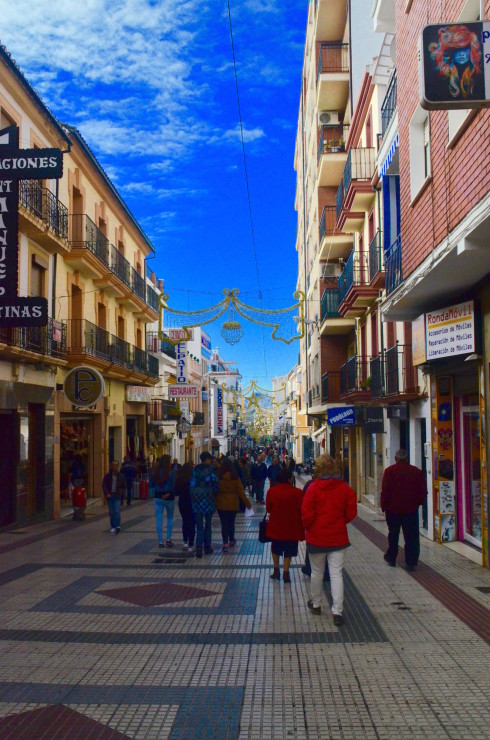
Plaza Socorro
The first thing that really grabs my attention is this view down a side street of a church steeple and, is that Hercules I see standing there? Must have a look.
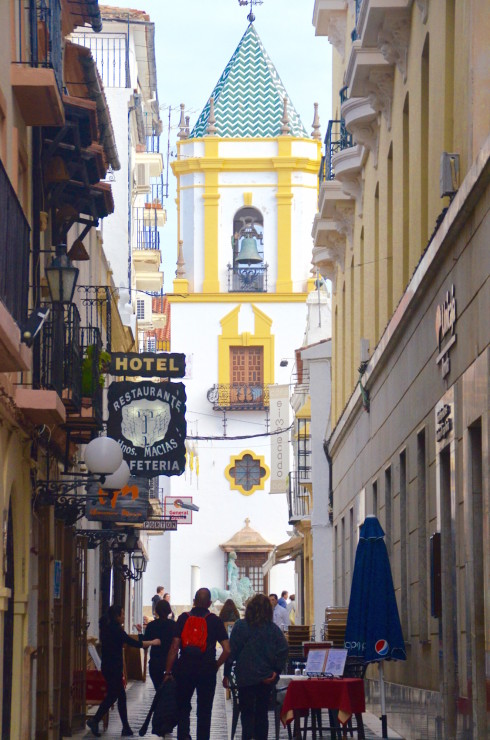
Why yes it is. He’s standing just in front of the famous pillars named after him which we visited a few days ago in Gibralatar. This is the Plaza Socorro which has immense significance to Rondeños as it was from a balcony just behind the statue that in 1918 Blas Infante declared Andalusia’s existence as a separate self-governing province within Spain. He unfurled the Andalusian flag which he designed. As you can see it has Hercules with two lions and the two pillars.

From then, until 1936, Andalusia was essentially it’s own country with Infante as a revered leader. That is until that murderous thug and friend of Hitler’s, Franco had he and his colleagues rounded up and summarily executed. So much for Andalusian independence. So the statue and fountain are really a tribute to Infante and the independence movement. It’s very well done and I’m learning a lot about Andalusian history and we haven’t even gotten to the main attractions of Ronda yet.
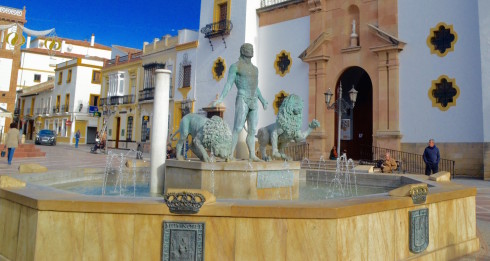
Directly beside the statue is the Nuestra Senora del Socorro which, despite it’s appearance, dates only from 1956. Just to prove that the fascists were not the only assholes during the Spanish Civil War, the previous church was burned to the ground by the Socialists in 1936. That was a bad year for Ronda.
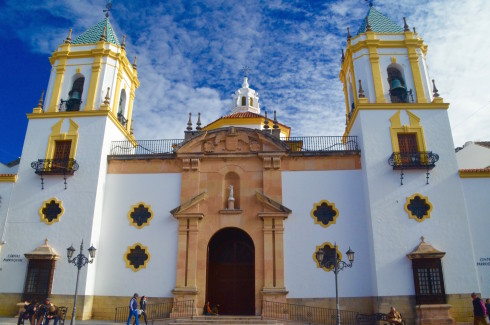
Bullfighting in Ronda
Turning our back on the church, literally and figuratively, we continue a very short distance to the Plaza de Toros de la Real Maestranza de Caballería de Ronda. How’s that for a mouthful? What it encompasses is the plaza in front of the bullring, the bullring itself and the museum of bullfighting that is housed inside. Let’s take a walk around before going in.
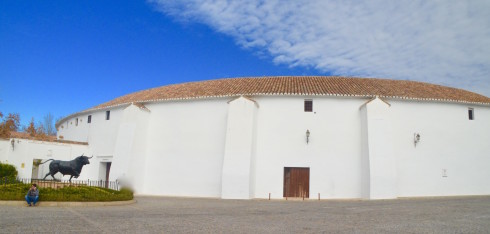
This magnificent statue of a bull guards the museum entrance.

On the opposite side is El Toro’s opponent, El Matador. My attempt to impersonate him is pathetic.
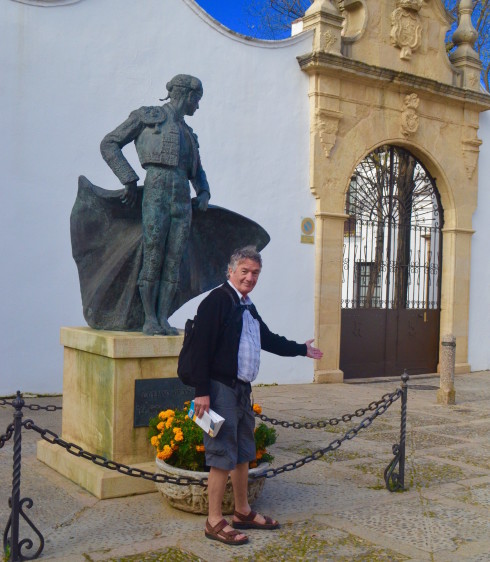
Also on the outside there is a plaque to you know who.
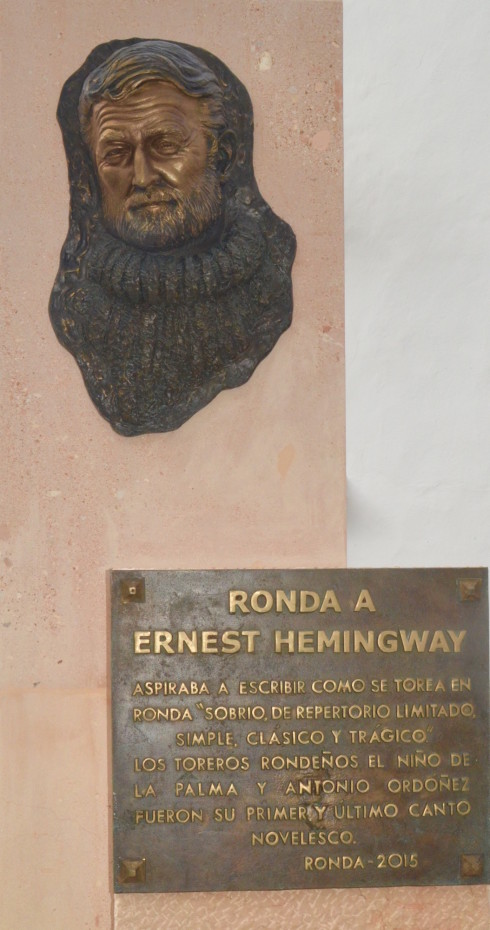
And someone I wasn’t expecting, Orson Welles.
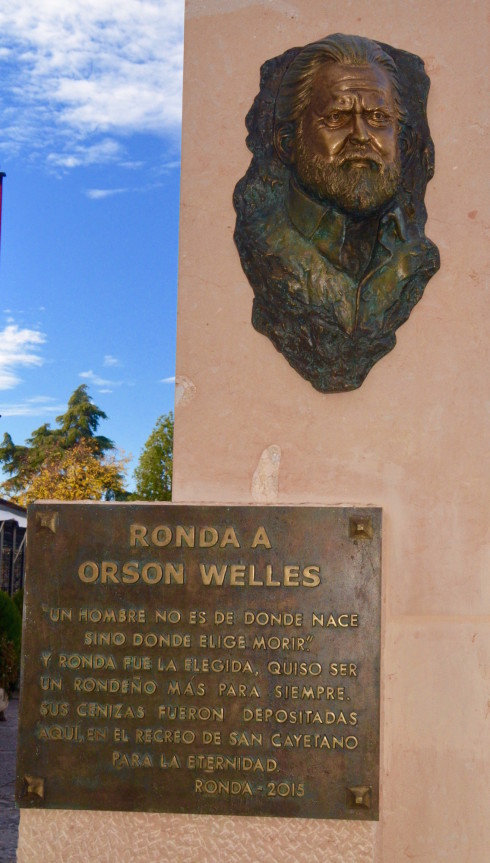
I had no idea that Welles spent as much time as Hemingway in Spain, was an important radio announcer for the Republican side during the civil war, loved bullfighting and brawled here with Hemingway in 1937 before settling matters over a bottle of whisky. Two years after his death his ashes were brought to Ronda and this is his final resting place. Who knew? That’s why travel is always a learning experience.
Death in the Afternoon is one of Hemingway’s non-fiction works although it does contain an element of fiction in the person of the old lady to whom the narrator tries to explain the intricacies of the art of bullfighting. Frankly, it’s not a very good read and did not, as some critics claim, make me want to witness a bullfight. Hemingway was right when he wrote about bullfighting, and I’m paraphrasing, that anything that can raise the passions for something in some people, will equally raise passions against it in others. In this age of P.E.T.A., bullfighting is definitely under siege and may well go the way of fox hunting in Britain. It’s already banned in Catalonia. However, that does not mean that the history, architecture, costumery, horsemanship and ritualism of bullfighting should be consigned to the dustbin of history. This will be the first time I’ve ever actually been inside a bullring and I’m very much looking forward to it. So let’s go.
The entry fee is 8.5€ and that includes a very detailed audio-tour of the museum that is contained inside, the bullring and the stables where horsemanship is still taught in Ronda. We started with the museum which gave the history of bullfighting and explained why Ronda is considered the place where the bullfight as practised today was invented. It was in this ring or its predecessor that the first matador got down off his horse and confronted a bull on foot. Up until this daring act, the fight between man and bull was always conducted entirely on horseback.
The museum is actually more interesting than I thought it would be. Everything from this giant skull of an extinct aurochs,
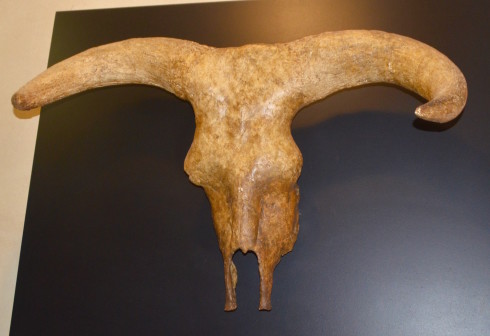
to the very colourful posters used to advertise the bullfights.
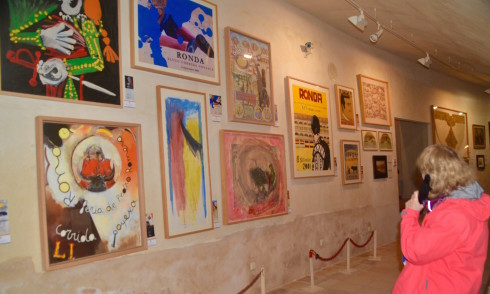
From the museum we followed a route that took us past the stables where these fine looking horses now reside in safety from the bullring. Until I read Death in the Afternoon, I had no idea that up until some modern protective changes were mandated, that the horses used in the spectacle were killed by being gored at alarmingly high rates. One thinks of the danger to the matador, but not necessarily to the horses. I must say that even if I could stand the sight of a bull being, in effect tortured, and then dispatched with a sword thrust to the heart, I could not abide the sight of a horse’s intestines being ripped out by a raging bull.
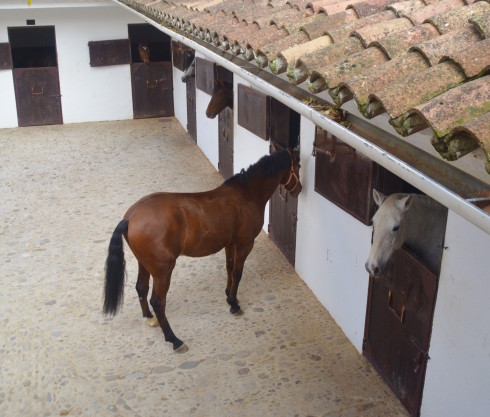
We then cross over the chute where the bulls are let out to enter the ring.
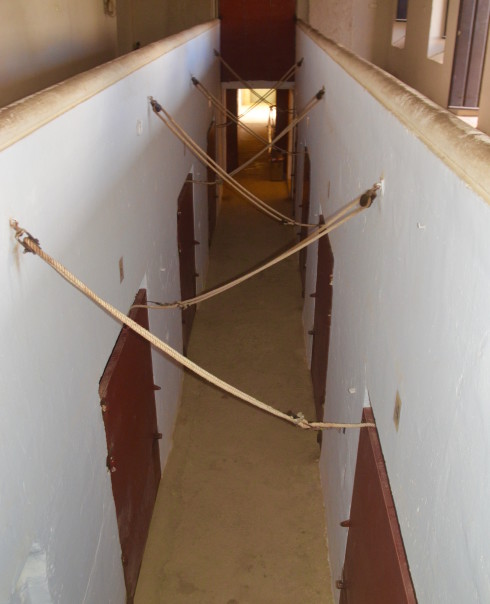
And at last we enter the ring proper. The symmetry is amazing.
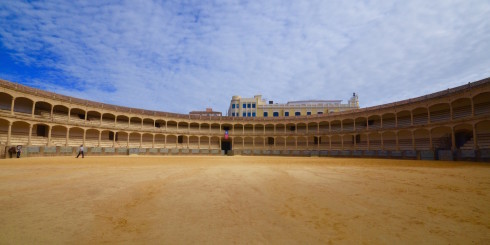
This is where one would stand to let the bulls into the ring, directly below the royal box.
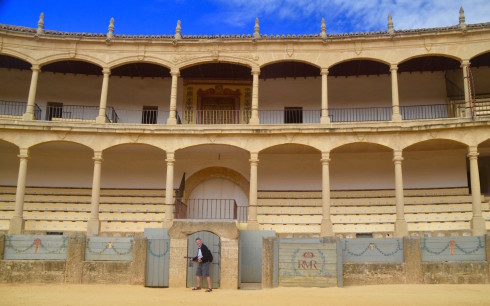
These are the tiled steps leading up to the second tier seats – each has a separate motif related to bullfighting.
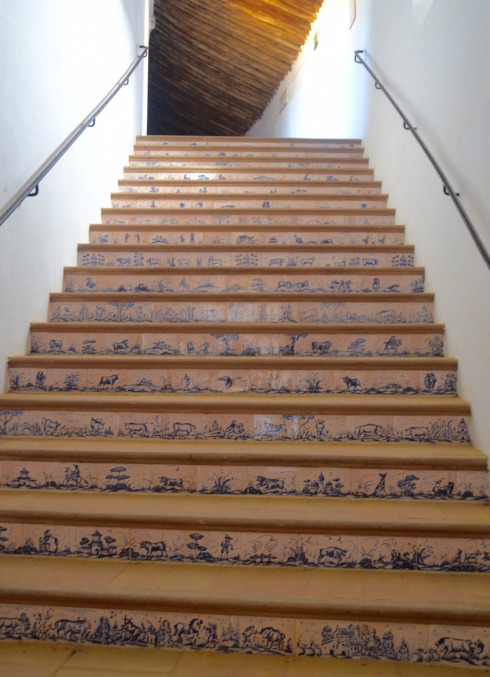
Here is the view from the second level.
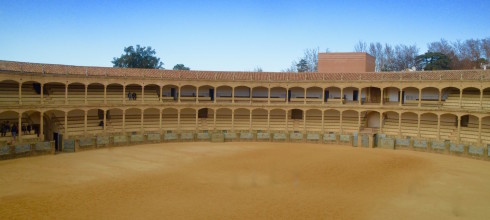
They still have bullfights or more properly corrida in this building, but usually only a few times a year, mostly in the late summer. I will definitely return to Ronda. I doubt it will be to see a bullfight, but you never know.
La Tajo de Ronda
We’ve been in Ronda for a good two hours and still haven’t seen La Tajo or any of the famous bridges that cross it. Time to remedy that as we exit the bullring and follow a sidewalk that leads to the mirador. The sidewalk contains a matadors walk of fame with the names and likenesses of the greatest bullfighters. This is Pedro Romero, a native of Ronda, who is considered the greatest matador of all time, credited (discredited to some) with killing over 6,000 bulls in the ring without being gored once. It was also the name Hemingway gave to the young matador in The Sun Also Rises who is seduced and debased by Brett purely for her own enjoyment.
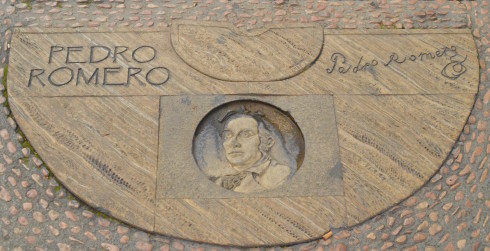
At the end of the walk of fame there is a gazebo where a harpist is playing very soothing music that seems like an antidote to the adrenalin rush created by being in the bullring.
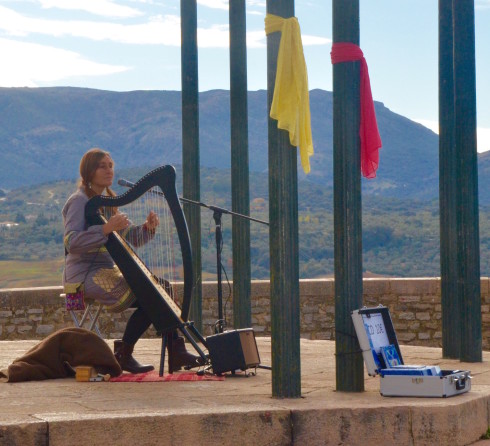
And then the view. It really is breathtaking. We seem to be a thousand feet above the plain below, although it’s more like a few hundred.
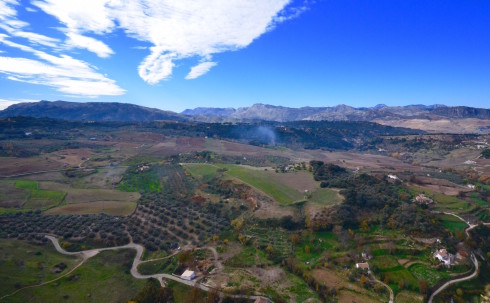
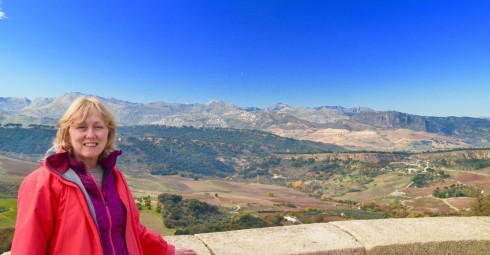
Here is a view of the mirador from afar. You can see why I thought it might be an inspiration for the Grand Canyon Skywalk. I’m not sure if the people on it are aware that they are literally hanging over the edge of the cliff.
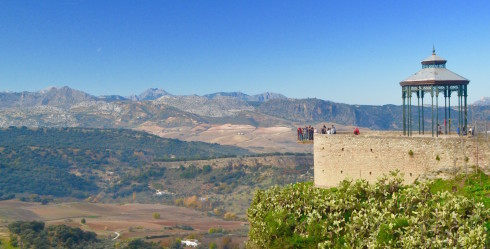
Puente Nuevo, Ronda
From the mirador you can walk along the edge of the gorge toward the Puente Nuevo or new bridge which is the most famous of the three that cross La Tajo. It’s not exactly new, completed in 1793, but it’s a marvel of engineering that took 34 years to complete.
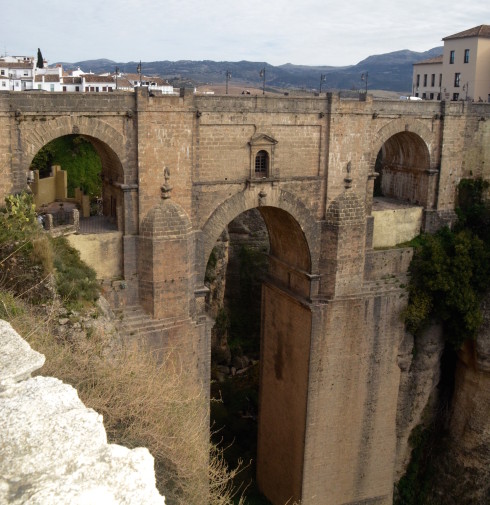
The view from the bridge shows just how precipitous the houses on the side of La Tajo are. Talk about living on the edge.
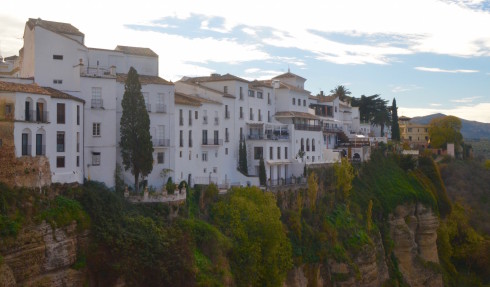
This is the view looking down. Not exactly for acrophobes. As you can see, there are pathways that make their way down the gorge which in turn lead to great hiking paths all throughout the area. Another reason to return.
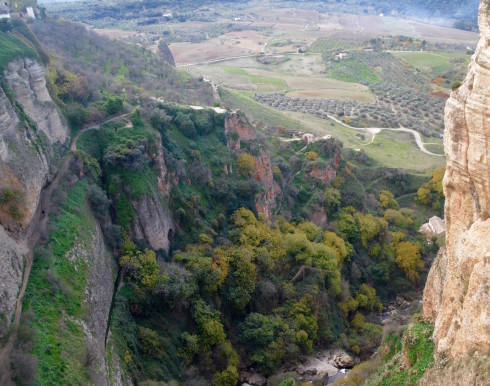
This is the bridge from the other side of Ronda which is the Moorish quarter that definitely begs exploring. That’s me in the middle.
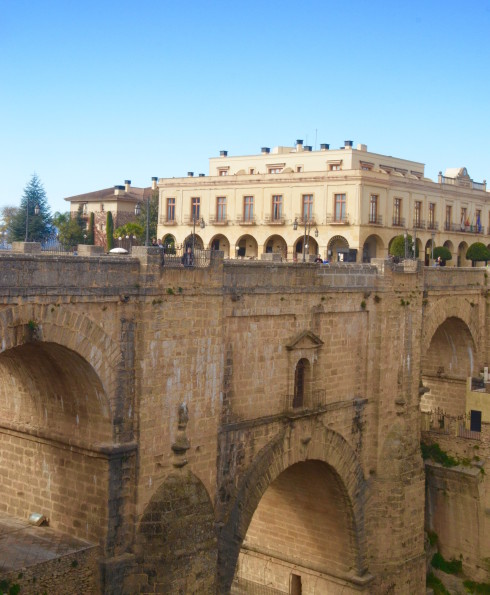
A closer look. You can lean over for a great look down at the gorge like the guy on the right is doing, but it might induce vertigo in some.
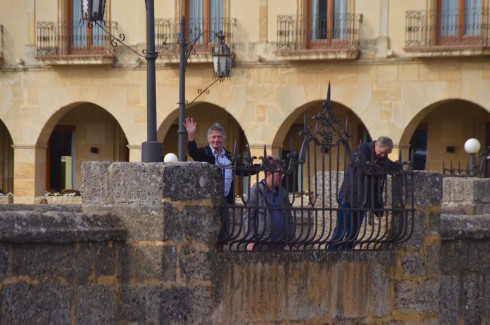
By now it’s well past time for lunch so we recross the bridge to Don Miguel restaurant which has a great outdoor patio just under the bridge. Sure it’s a touristy place, but this nine tapas plate is more than adequate.
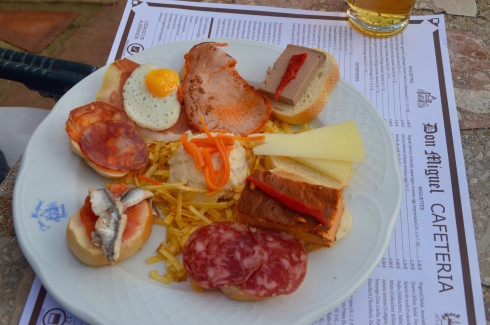
As is the selection of Andalusian sausages.
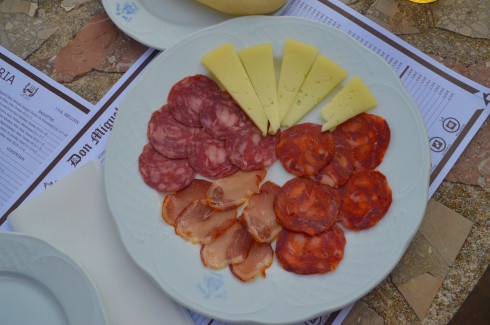
We are running late and have miles to go before we sleep, so it is time to leave Ronda, but I can say as definitively as Douglas MacArthur, “I will return.”. And I know exactly where we will stay. The Parador of Ronda sits perched at the edge of La Tajo with what must be among the best views from any hotel in Spain.
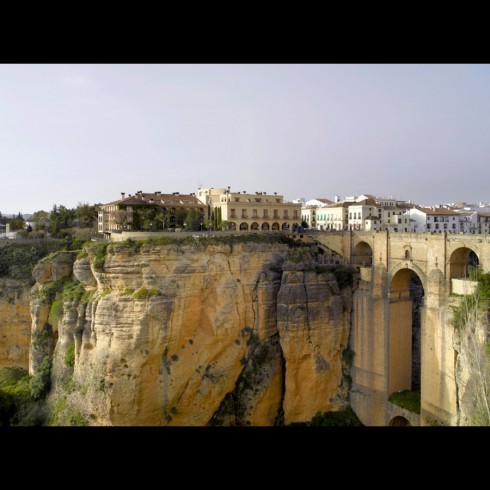
Adiós from Ronda. See you in Cordoba.
If you are partial to small untouristy Spanish towns then you need to read this post on La Seu d’Urgell in the foot of the Pyrenees.

